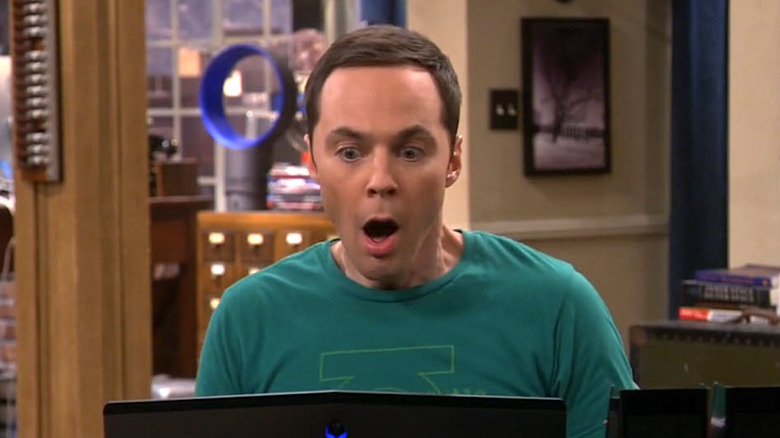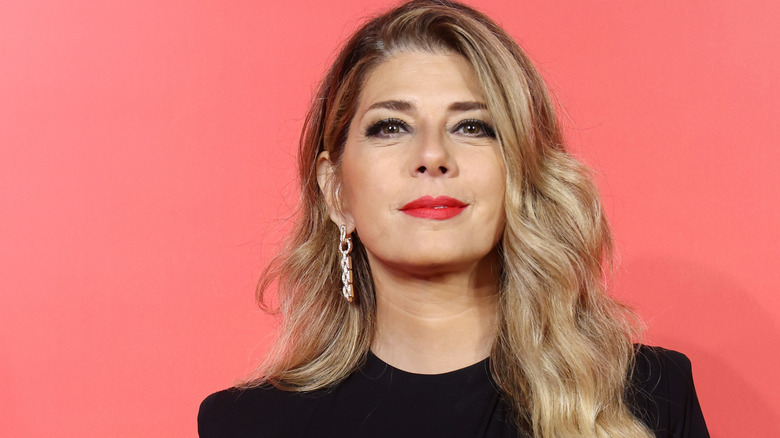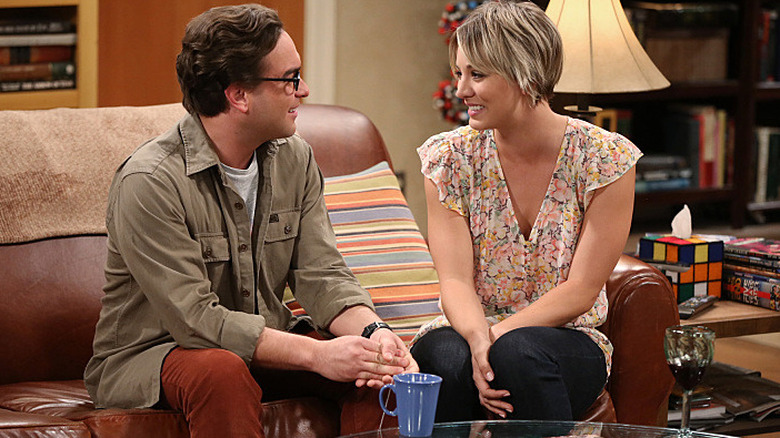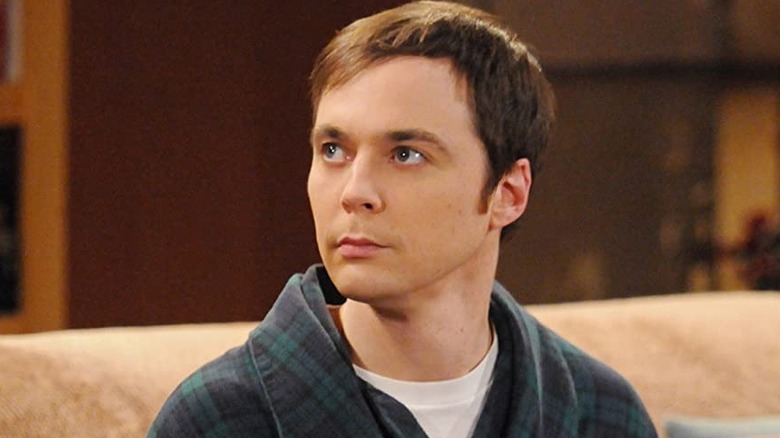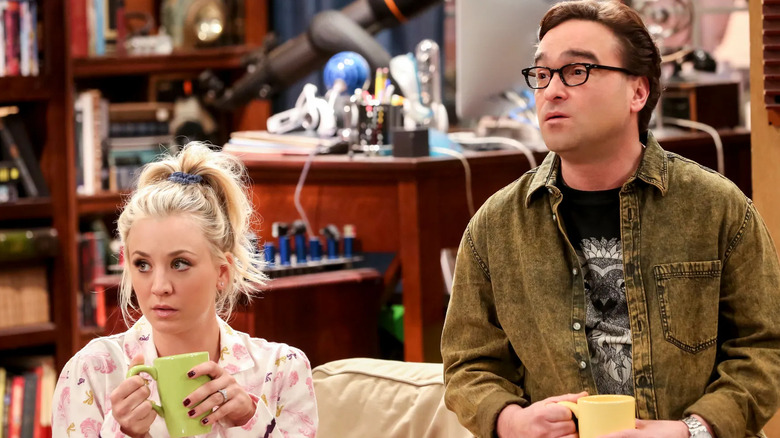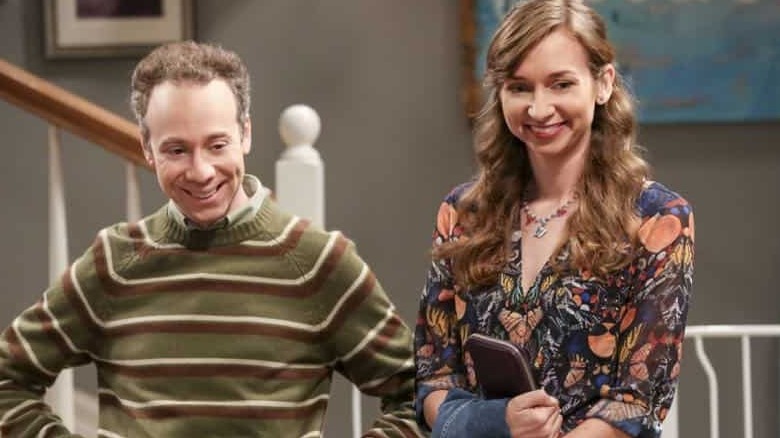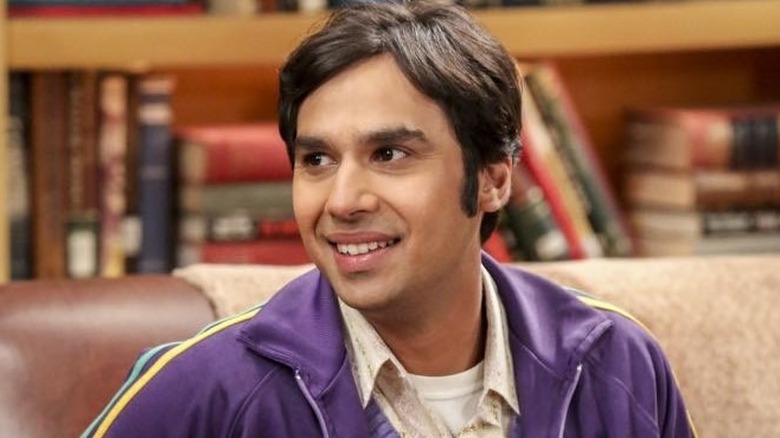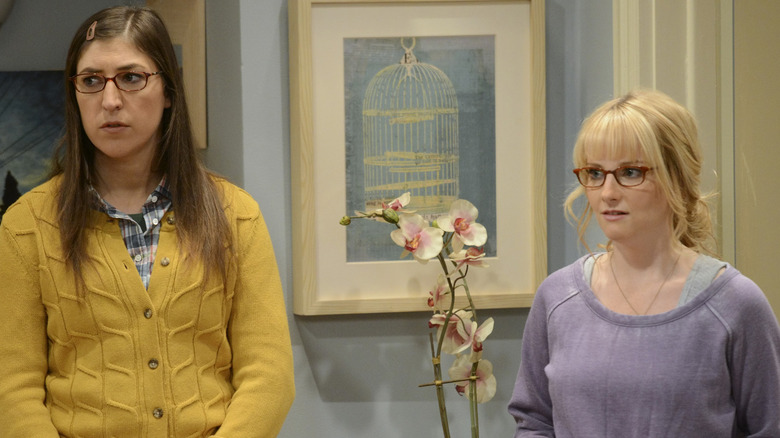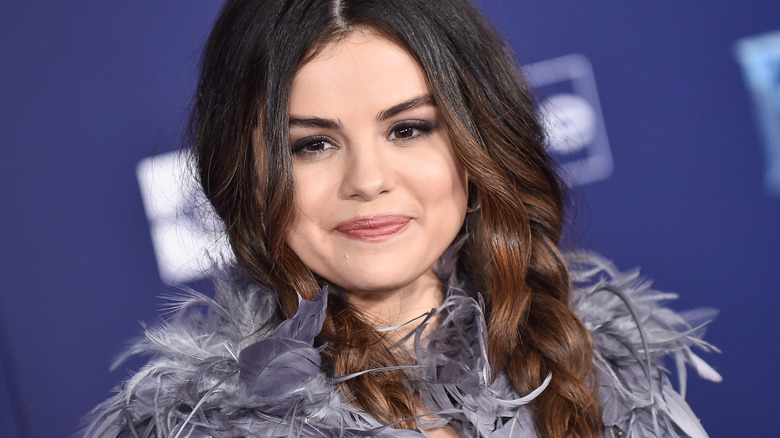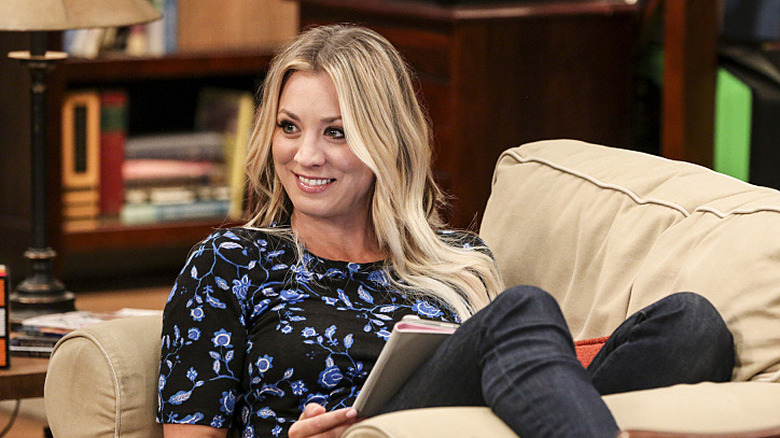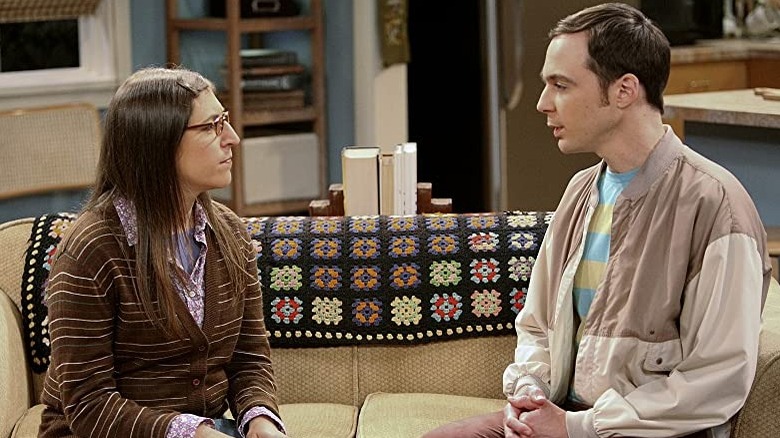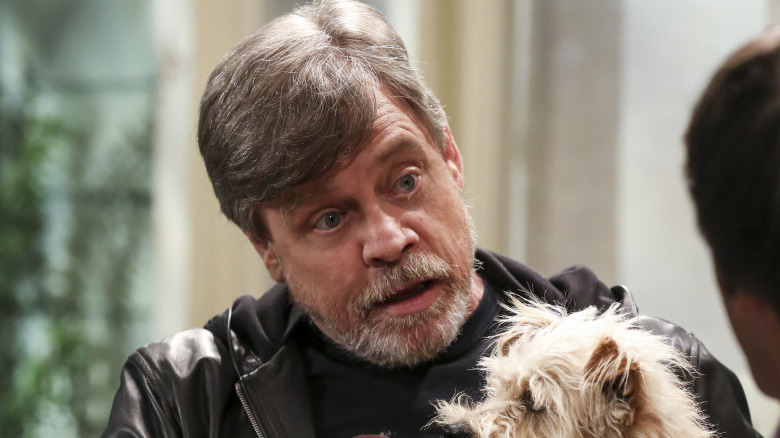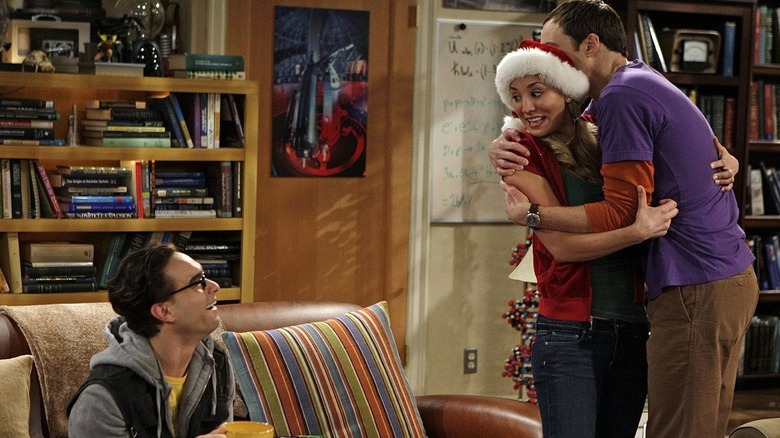The Most Eye-Opening Things We Learned In The Big Bang Theory Book
One could argue that "The Big Bang Theory" was the last great sitcom to hijack the zeitgeist. The hallmarks of "The Big Bang Theory" and its classic sitcom ilk — iconic hangout spots, live studio audiences, and a will-they-won't-they relationship — are elements that some fans have grown to miss in today's television landscape. Since the show's rise to prominence and eventual conclusion, the conversation has never really fully shifted away from it; to this day, fans debate the show's portrayal of women, color, and, most notably, geek culture. As a result, its relevance has never truly waned.
Of course, fans love revisiting their favorite old TV shows and movies. A handful of recent projects — the "Friends" and "Harry Potter" reunions on HBO Max, the "Offices Ladies" podcast, and the "Woke Up This Morning" podcast to name a few — offer the audiences of their respective shows behind-the-scenes info straight from the stars and crew themselves. In that same spirit, the new book "The Big Bang Theory: The Definitive, Inside Story of the Epic Hit Series" by Jessica Radloff unleashes the reality of what happened during the show's production. It gives viewers first-person retellings of all the known and unknown stories behind the show's creation. Here are the essential takeaways.
Marisa Tomei could've played Penny
Penny is one of the show's most important characters. There's a solid case to be made that "The Big Bang Theory" wouldn't function without Kaley Cuoco. Several TV executives, in fact, felt the same way. Penny was initially designed to be a foil to Leonard and Sheldon when Chuck Lorre presented the show's pilot to several networks. However, that plan changed after test audiences and TV executives were unimpressed with that version of Penny. As a result, we eventually got the version of Penny that highlights the shortcomings of the guys.
As devoted fans may already be aware, the first Penny wasn't even named Penny; she was named Katie. She was also not portrayed by Kaley Cuoco. That story is clarified more in the book. Penny's first incarnation was dark, and interestingly, Marisa Tomei was one of the leading candidates for the role.
Though she's been famous for decades, in recent years Tomei is most widely recognized for playing "Aunt" May Parker in the MCU's "Spider-Man" trilogy. Jim Parsons was quoted in People Magazine as saying, "Oh my gosh, what a different world that would have been" with Tomei playing Penny, and it's difficult to disagree. The dynamic between Sheldon and Penny is undoubtedly one of the show's highlights, and it's difficult to imagine a version in which Penny isn't a bubbly and understanding delight who challenges Sheldon's misanthropy.
Kaley Cuoco had feelings for Johnny Galecki early on
A slow-burn romance between two main characters is one of the pillars of a great sitcom. "Friends" has Rachel and Ross; "The Office" has Jim and Pam; "Abbott Elementary" has Janine and Gregory, and "The Big Bang Theory" has Leonard and Penny. The physicist and the aspiring actor each have something the other needs to grow; Penny needs Leonard to help her with her commitment issues and Leonard needs Penny's help building his confidence.
However, by now many viewers know that the actors who played Leonard and Penny were also romantically involved. In the book, Kaley Cuoco revealed that this mutual attraction began pretty quickly. "I had a very big crush on Johnny early on," she said. But, of course, both were in different relationships when their attraction began. Still, it became real when Johnny Galecki invited Cuoco on a wine date, and the rest, as they say, is history.
For a long time, the two managed to keep their relationship hidden from not only the media, but also the rest of the cast and crew of the show. However, the sneaking around ultimately led them to decide to reveal their relationship to creator Chuck Lorre at Comic-Con.
"We were in the shuttle bus [and] I'm sitting next to Kaley and I'm trying to have a conversation," Lorre remembered. "'So what's going on? You seeing anybody? What's going on with you?' And she goes, 'Oh my god, you don't know.' And I'm going, 'I don't know what?' [...] I was the last to find out."
Sheldon's sexuality
Sheldon's relationships are a major source of comedy in the series. He does not like other people. He even hilariously categorizes his pals; Leonard, Penny, and Raj are his best friends, whereas Howard is only a "treasured acquaintance." And when he is interested in someone, such as Leonard's mother, it is typically not romantic. Furthermore, Sheldon's romantic exploits are frequently one-sided, whether it's his one-time date with Lalita or his awkward platonic connection with Ramona.
According to the book, Chuck Lorre initially pushed for Sheldon to be asexual. People Magazine quoted him telling Jessica Radloff, "Sheldon's passion was learning; understanding the secrets of the universe. That made him unlike any character I certainly had ever seen. He wasn't trying to find himself in a relationship; he was in a relationship, and it was with science." This obviously all changed when Amy joined the gang.
An asexual Sheldon would've been interesting, given that sort of depiction in pop culture is uncommon. On the other hand, the writers chose to make Sheldon meet his match in Amy. In some ways, this works better for the show since it gives Sheldon's character arc a sense of growth.
Leonard and Penny's break-up mirrored real life
Leonard and Penny's romance finally takes off at the start of the third season. They had several false starts by that time, primarily owing to Leonard's tendency to ruin the moment and Penny's sense of inadequacy about not being educated enough to date him. When they eventually start dating, though, things come to a standstill when Leonard tells Penny he loves her, and she can't say it back.
In the book, co-creator Bill Prady stated that Cuoco confided in him that the writing on the show accurately captured what Galecki and Cuoco experienced during their separation. Vanity Fair published an excerpt from Jessica Radloff's book in which Prady said, "I remember Kaley mentioning something we had written and her telling us it was surprisingly accurate to something they'd gone through."
Unlike their on-screen counterparts, though, Galecki and Cuoco never reunited. However, both pairs ended up in good situations. In the show, the two were married and expecting a kid at the end, and in real life, they are still good friends to this day.
Simon Helberg wasn't the first choice for Howard
Howard Wolowitz is the show's closest thing to a villain. That's not because he's a horrible guy, but because he needs to grow the most out of the bunch. He is frequently creepy with ladies and makes incredibly inappropriate remarks about his closest friend Raj. However, as the series progresses, the introduction of Bernadette and the exploration of his relationship with his mother reveal another side of him. The character's intricacy keeps him compelling throughout the show. And it's all held together by Simon Helberg's performance.
In another reality, though, Simon Helberg did not play Howard Wolowitz. Kevin Sussman was the first choice for the role, but he couldn't take it due to a contractual obligation with "Ugly Betty." According to Entertainment Tonight, this revelation even shocked Jessica Radloff, and she was initially hesitant to tell Helberg.
Of course, Sussman ended up playing Stuart Bloom, the owner of the comic book store frequented by the gang. In an amusing twist of fate, Helberg found himself comforting Radloff since she was so shocked by the news. Radloff then praised Sussman for never bringing up the fact that he was the first choice for Howard throughout the entire show's production, adding, "He never wanted to get in Simon's head."
Chuck Lorre had to fight to keep Kunal Nayyar
Raj is first introduced to fans as the gang's pal who can't talk to women while sober. When he drinks, he has the confidence to speak to women ... but can only do so in an offensive manner. Kunal Nayyar generally performed the character lightheartedly, and he always had a fantastic sense of humor with the show's writing, despite usually being the butt of jokes.
So Jessica Radloff's revelation that CBS initially chose to go behind Chuck Lorre's back in order to replace Nayyar came as a great surprise. "Apparently, while I was flying across the country, a CBS executive determined — unilaterally — that Kunal wasn't right for the role, and we would recast that part," Lorre said in the book.
Lorre immediately went to CBS executives to express his unhappiness at being belittled and to make it clear that he would not allow Nayyar to depart the show without a fight. And for a man who was often seen as the angriest man on television, he eventually got his way. Since then, Raj has joined the pantheon of brilliant television supporting characters.
The main cast took pay cuts to facilitate raises for Bialik and Rauch
Most sitcoms feature a core ensemble of friends, coworkers, or family members who are introduced to the audience early on. Depending on how many people watch the show, it may be on the air long enough for fans to grow along with the characters. However, every now and again, a single show manages to break the mold. Such a show is "The Big Bang Theory," in which minor characters who join the ensemble in the middle of the series eventually play roles that are just as significant as those played by the main cast members who are present from the beginning.
Amy and Bernadette, played by Mayim Bialik and Melissa Rauch, are undoubtedly such characters. When they first join the cast, their storylines are concentrated solely around their respective boyfriends, but as the episodes progressed, both the writers and the viewers became more interested in these characters as individuals. Unfortunately, their actors' salaries did not reflect this. The book revealed that to compensate for this, the original five cast members each took a wage cut to ensure the network raised Bialik and Rauch's pay.
It's always good to see co-stars stand together, especially concerning pay disparities disproportionately affecting women.
Selena Gomez almost appeared as a guest star
"The Big Bang Theory" became a pop-cultural behemoth, and for sitcoms, that generally means big stars making appearances on the show. "The Office" went from a first season with no major celebrities (except for post-"40-Year-Old Virgin" Steve Carell, of course) to having guest stars like James Spader and Idris Elba in the later seasons. It goes without saying celebrity cameos on "The Big Bang Theory" became commonplace. But they didn't always pan out as intended.
Selena Gomez was one of the stars who never made it to the show. In Jessica Radloff's book, Steven Molaro, one of the show's producers, talked about the moment Selena Gomez shared a social media photo of herself watching the show. Molaro then reached out to her team to see if they could plan a guest star spot for Gomez, but her hectic schedule prevented her from appearing on the show.
Although Molaro never made it to the pitching stage, he did reveal that the writers were contemplating having Gomez play Amy's stepsister. The idea was to make Amy slightly irritated with Gomez's character and envious of her since, in Molaro's words, the star of "Only Murders in the Building" is "beautiful and great."
Kaley Cuoco almost had her leg amputated
Penny is presented in "The Big Bang Theory" as having an active and sporting lifestyle. Her father wanted a boy, so when he got Penny, he raised her just like he would a son. As a result, Penny is good with engines, enjoys sports, and once stole a horse while intoxicated in high school. In that particular regard, her real-life counterpart, Kaley Cuoco, is no different. Cuoco is well renowned for her love of horses.
However, the only problem with an active lifestyle is sometimes it leads to terrifying injuries. Cuoco experienced this during a horse-riding accident. Chuck Lorre and Cuoco reminisced about that specific incident in the book, saying how it almost led to her leg's amputation. According to People Magazine, Cuoco fell from her horse in 2010 because the horse was startled by something, and while she was on the ground, the animal trod on her left leg.
Cuoco, thankfully, did not lose her leg. Nonetheless, the anxiety was valid and spread among the cast and crew. While Cuoco later remarked that the experience was still too new and horrific for her to relive fully, she was back on her feet in a matter of weeks. However, despite her injuries, she returned to work, but needed to employ a body double in circumstances when Penny needed to walk.
Jim Parsons blindsided the cast by announcing his exit
It's no secret that the first season of "The Big Bang Theory" is centered around Leonard and Penny's romance, with Sheldon serving as a quirky friend who balances the drama with humor. But as the series progressed, the audience grew to adore Sheldon and got invested in seeing him overcome his struggles, especially in terms of how he interacts with others. So in a way, the show became an ensemble piece with Sheldon at its heart. That was due in large part to Jim Parsons' endearing performance in the role.
However, after 12 seasons, Parsons thought it was time to let go and move on with his career. Parsons proposed to Lorre that he depart the show and they all carry on without him. The only problem was that none of the other cast members were aware of Parsons' feelings. Galecki stated, "I don't even disagree with how Jim felt, because in many ways, I felt the same way. I just disagreed with how it was managed."
The cast and crew decided against continuing the show without him since they thought it wouldn't work if one of the cast members left. So, after expressing their feelings, they all agreed to end the show after Parsons voiced his intention to leave.
Mark Hamill appreciated the show more in hindsight
Mark Hamill is, without a doubt, one of the most influential actors of his generation. In geek culture, though, his work in "Star Wars" movies and "Batman: The Animated Series" has made him a virtual deity. So it's no surprise that Hamill was considered for a guest appearance on the show. Luckily, his schedule permitted him to stop by "The Big Bang Theory."
However, while Hamill agreed to appear on the show, he had only seen a couple of episodes and had no idea how important the show was to pop culture at the time. "It took me months and months and months," Hamill told Jessica Radloff, "but I've seen them all now. I knew they referenced all kinds of pop culture, and the characters loved comic books, science fiction, fantasy, etc., but I had no idea how ingrained it was and how they could be so subversive in their humor."
He also mentioned how the series made a sly reference to "Phantom Menace" and how the film is still seen as unsatisfactory by its core audience. Hamill admitted that his appearance and subsequent viewing of the entire show made him regret his approach to the performance. Hamill conceded, "I wish I had done this in reverse, so I knew more about it when I did it."
The writers meticulously planned Sheldon's decision to hug Penny
Later in the show's existence, the emphasis moves to Sheldon's growth and struggles, especially with his dislike of the human touch. One way the sitcom portrays this is through Penny's friendship with Sheldon. It begins with them aggravating each other a lot, but the audience gradually realizes how precious their friendship is. Penny looks after Sheldon when he is unwell, and Sheldon returns the favor when Penny dislocates her shoulder.
Sheldon's journey and friendship with Penny climaxes with an uncharacteristic hug initiated by Sheldon. Even though the hug is out of character, it's well-planned and earned. In the book, Parsons explained, "The construction of the scene was more moving to me than the joyous ecstasy that the character was going through. The emotion I feel even as I talk about it now has to do with the chill it gave me that they put something like that together. This was a character who displayed so few emotions, especially early on, and the writers came up with the most ridiculous trigger for him to finally reveal emotion and to such a degree that he was compelled to hug Penny."
Parsons was referring to the Christmas episode in which Penny gives him a napkin used and signed by Leonard Nimoy. Sheldon is overwhelmed with gratitude and reasons that the only way he can repay her generosity is to hug her. After all, there's no better way to commemorate friendship than with small yet thoughtful gifts.
